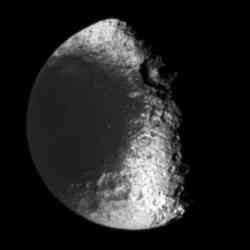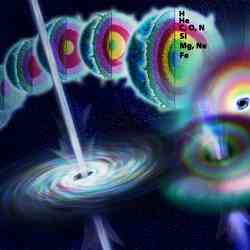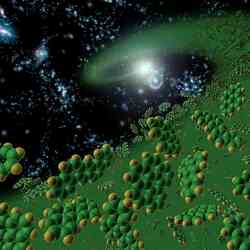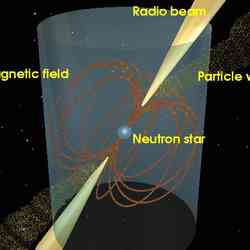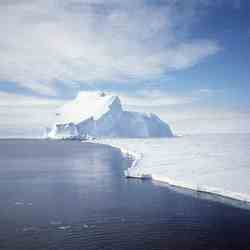
Earth factors may be the most probable scenario for past mass extinctions. Image credit: NASA Click to enlarge
Most scientists agree that a large meteor probably wiped out the dinosaurs 65 million years ago, but two geologists from the University of Leicester think that some homegrown cataclysms might have done the trick for previous extinctions. There just isn’t enough evidence that an impact caused the mass extinction that happened 250 million years ago. But one of the largest flood basalt eruptions did occur at that time, and released enough greenhouse gasses to dramatically change the Earth’s climate – killing the dinosaurs off in the process.
Earth history has been punctuated by several mass extinctions rapidly wiping out nearly all life forms on our planet. What causes these catastrophic events? Are they really due to meteorite impacts? Current research suggests that the cause may come from within our own planet – the eruption of vast amounts of lava that brings a cocktail of gases from deep inside the Earth and vents them into the atmosphere.
University of Leicester geologists, Professor Andy Saunders and Dr Marc Reichow, are taking a fresh look at what may actually have wiped out the dinosaurs 65 million years ago and caused other similarly cataclysmic events, aware they may end up exploding a few popular myths.
The idea that meteorite impacts caused mass extinctions has been in vogue over the last 25 years, since Louis Alverez’s research team in Berkeley, California published their work about an extraterrestrial iridium anomaly found in 65-million-year-old layers at the Cretaceous-Tertiary boundary. This anomaly only could be explained by an extraterrestrial source, a large meteorite, hitting the Earth and ultimately wiping the dinosaurs – and many other organisms – off the Earth’s surface.
Professor Saunders commented: “Impacts are suitably apocalyptic. They are the stuff of Hollywood. It seems that every kid’s dinosaur book ends with a bang. But are they the real killers and are they solely responsible for every mass extinction on earth? There is scant evidence of impacts at the time of other major extinctions e.g., at the end of the Permian, 250 million years ago, and at the end of the Triassic, 200 million years ago. The evidence that has been found does not seem large enough to have triggered an extinction at these times.”
Flood basalt eruptions are – he says – an alternative kill mechanism. These do correspond with all main mass extinctions, within error of the techniques used to determine the age of the volcanism. Furthermore, they may have released enough greenhouse gases (SO2 and CO2) to dramatically change the climate. The largest flood basalts on Earth (Siberian Traps and Deccan Traps) coincide with the largest extinctions (end-Permian, and end-Cretaceous). “Pure coincidence?”, ask Saunders and Reichow.
While this is unlikely to be pure chance, the Leicester researchers are interested in precisely what the kill mechanism may be. One possibility is that the gases released by volcanic activity lead to a prolonged volcanic winter induced by sulphur-rich aerosols, followed by a period of CO2-induced warming.
Professor Andy Saunders and Dr. Marc Reichow at Leicester, in collaboration with Anthony Cohen, Steve Self, and Mike Widdowson at the Open University, have recently been awarded a NERC (Natural Environment Research Council) grant to study the Siberian Traps and their environmental impact.
The Siberian Traps are the largest known continental flood basalt province. Erupted about 250 million years ago at high latitude in the northern hemisphere, they are one of many known flood basalts provinces – vast outpourings of lava that covered large areas of the Earth’s surface. A major debate is underway concerning the origin of these provinces -including the Siberian Traps- and their environmental impact.
Using radiometric dating techniques, they hope to constrain the age and, combined with geochemical analysis, the extent, of the Siberian Traps. Measuring how much gas was released during these eruptions 250 million years ago is a considerable challenge. The researchers will study microscopic inclusions trapped in minerals of the Siberian Traps rocks to estimate the original gas contents. Using these data they hope to be able to assess the amount of SO2 and CO2 released into the atmosphere 250 million years ago, and whether or not this caused climatic havoc, wiping out nearly all life on earth. By studying the composition of sedimentary rocks laid down at the time of the mass extinction, they also hope to detect changes to seawater chemistry that resulted from major changes in climate.
From these data Professor Saunders and his team hope to link the volcanism to the extinction event. He explained: “If we can show, for example, that the full extent of the Siberian Traps was erupted at the same time, we can be confident that their environmental effects were powerful. Understanding the actual kill mechanism is the next stage. watch this space.”
Original Source: University of Leicester



